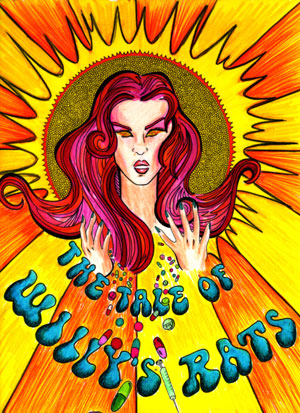 By MICK FARREN (Funtopia; 1973/2002)
By MICK FARREN (Funtopia; 1973/2002)
The late Mick Farren (1943-2013) was England’s answer to our own John Shirley: a troublemaking rock musician who subsequently found fame (of a sort) writing pulpy horror and sci fi novels. Shirley, of course, cleaned up his act in his later years, something I’m not sure Farren ever did; fittingly, one of his final publications was the nonfiction study SPEED-SPEED-SPEEDFREAK: A FAST HISTORY OF AMPHETMINE. In THE TALE OF WILLY’S RATS, Farren’s third novel, he went the write-what-you-know route, charting the misadventures of a 1960s-era UK rock group closely patterned on Farren’s own band The Deviants, with whom he was active during the years 1967-69. The novel, for the record, debuted as a paperback original in ‘73 (with what Farren has since dubbed a “truly hideous cover image”), and reappeared as an e-text in the early 00s.
In a newly written introduction Farren claims the novel consisted of “bits of scrambled autobiography, incidents that happened with the Deviants both on and off stage, incidents that might have happened, but didn’t, and probably a whole mess of ego-maniac wish fulfilment.” The result is a plotless and meandering, but compelling nonetheless, account; Farren’s considerable writing talent, even at such an early stage, is evident in the way the book so ruthlessly compels one’s attention regardless of how rambling and formless it becomes. There may exist slicker UK-centric rock novels (ESPEDAIR STREET by Iain Banks comes to mind), but THE TALE OF WILLY’S RATS, with its unabashedly messy, sleazy grandeur, stands very near the top of the heap.
The narrator is Lou Francis, the lead singer of Willy’s Rats. He begins and ends his tale with a concert in America, where Lou is feeling quite apprehensive about a dangerous letter-writer who we learn more about in the book’s final third. Before that we get a history of Willy’s Rats from Lou’s highly erudite, philosophically inclined perspective; he views rock ‘n’ rollers as modern-day deities, and is given to observations like “A chick let us in who looked like she’d fallen out of a copy of Harper’s” and “it’s amazing how patronizing a successful band can be to an unsuccessful one when you think of what a great part chance plays in the rock business.”
Of course, the behavior of Lou and his fellows doesn’t exactly bespeak an excess of deep thought. Rising up through swinging sixties London, Lou and his bandmates, who take their band’s name from William Burroughs’ NAKED LUNCH, are given to wild, satanic onstage antics. Illicit drugs naturally play a large part, as do assorted sexcapades with a vast number of women that encompass a wide spectrum of erotic expression (hence the “sleazy” qualifier utilized above).
As the Rats’ fame increases so does their collective appetite for excess, which catches up to them in the form of the aforementioned anonymous letter writer, who makes some disturbing death threats. Further trouble occurs in the form of a Charles Manson inspired hippie cultist whose dark sanctuary Lou enters near the end; what he discovers therein is pretty shocking, and closes things out on an overtly horrific note that foreshadows many of Mick Farren’s subsequent novels, in which the rockers on display here were replaced with vampires and the undead. Like I said, this guy wrote about what he knew.
